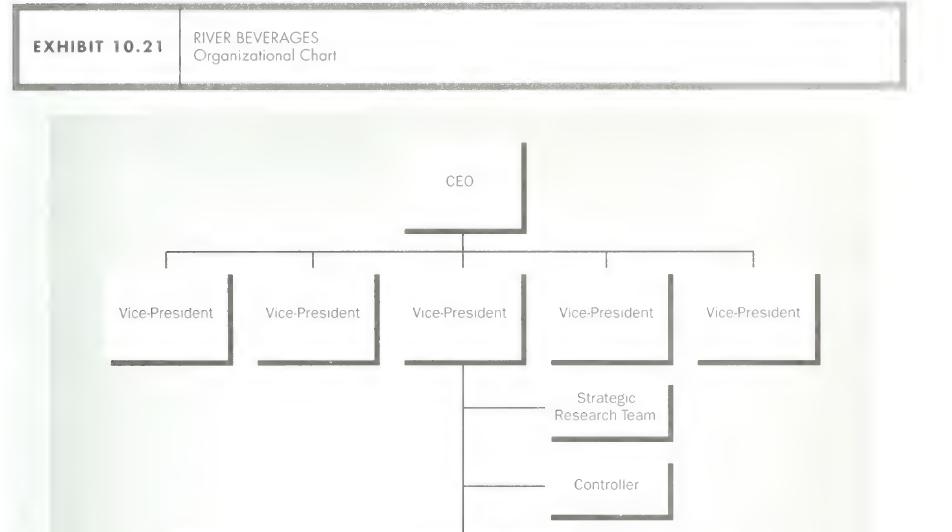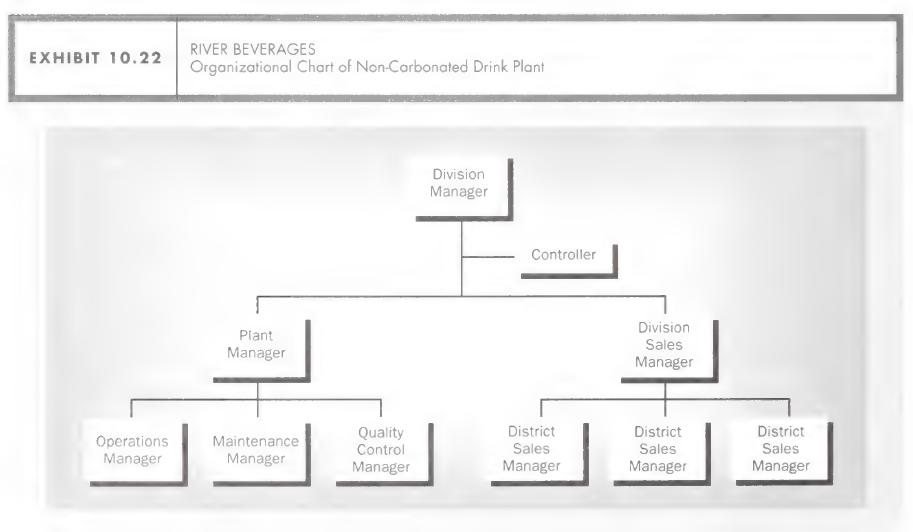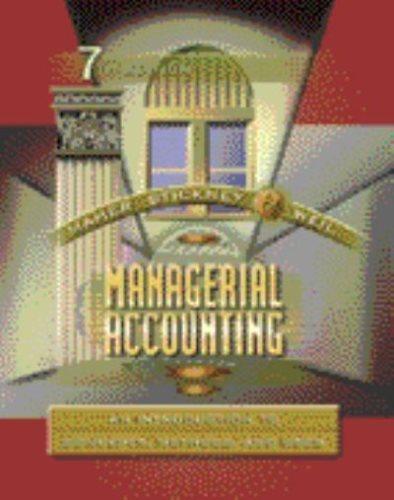Budgeting Case: River Beverages* Overview River Beverages is a food and soft drink company with worldwide operations.
Question:
Budgeting Case: River Beverages*
Overview River Beverages is a food and soft drink company with worldwide operations.
The company is organized into five regional divisions with each vice-president reporting directly to the CEO, Cindy Wilkins. Each vice-president has an R&D department, a controller, and three divisions — Carbonated Drinks, Non-Carbonated Drinks, and Food Products
(see Exhibit 10.21). Management feels that the structure works well for River because different regions have different tastes and the divisions' products complement each other.

Industry The beverage industry in the United States has become mature as it has grown in stride with population growth. Most of the industry growth has come from the nonalcoholic beverage market, which is growing by about 1.1 percent annually. In the nonalcoholic arena, soft drinks are the largest segment. Bottled water is the next largest segment, followed by juices. The smallest but fastest-growing segment is ready-to-drink tea, which is growing by over 90 percent in volume but accounts for only about 3 percent of the beverages consumed.
Sales Budgets Susan Johnson, plant manager at River Beverage's Non-Carbonated Drink plant in St. Louis (see Exhibit 10.22), recently completed the annual budgeting process. According to Johnson, division managers have decision-making authority in their business units except for capital financing activities. Budgets are used to keep the division managers focused on corporate goals.
In the beginning of December, division managers submit a report to the vice-president for the region summarizing capital, sales, and income forecasts for the upcoming fiscal year, which begins July 1. Although the initial report is not prepared in much detail, it is prepared with care because it is used in the strategic planning process.
Next, the strategic research team begins a formal assessment of each market segment in its region. The team develops sales forecasts for each division and compiles them into a company forecast. The team considers economic conditions and current market share in each region. Management believes the strategic research team is effective because it is able to integrate division products. In addition, the team ensures continuity of assumptions and achievable sales goals for the company as a whole. The work done by the strategic research team is shared with top management and division managers. Division managers typically do not share the information from the strategic research team with the district sales managers because the division managers want the district sales managers to derive their own estimates independent of such input.
In early February, the district sales managers estimate sales for the upcoming budget year. The district sales managers are ultimately responsible for the forecasts they prepare. The district sales forecasts are then compiled, coordinated by the division sales manager and returned to the division manager. The division manager reviews the forecasts, but does not make any revisions without first consulting the district sales managers. Next, the district sales forecasts are reviewed by the strategic research team and the division controller. Finally, top management reviews each division's competitive position, including plans to increase market share, capital spending, and quality improvement plans.
Plant Budgets After the sales budget is approved by top management, it is broken down to a sales budget for each plant. The budget is broken down further by price, volume, and product type. Plant managers budget variable costs, contribution margins, fixed costs, and pretax income using information from the sales budget given to the plant.
Plant managers derive budgeted pretax income by subtracting standard variable costs and budgeted fixed costs from the sales forecast. If actual sales fall below forecasts, the plant manager is still responsible for budgeted pretax income.
The operations and maintenance managers work together to develop cost standards and cost reduction targets for all departments. Budgeted cost reductions from productivity improvements, unfavorable variances, and fixed costs are developed for each department, operation, and cost center in the plant.
Before plant managers submit their budgets, a member of the strategic research team and the regional controller visit the plant. These visits are conducted to keep corporate in touch with what is happening at the plant level and to help corporate understand how plant managers determined their budgets. The visits also allow corporate to provide budget preparation guidance if necessary. The visits are especially important because they force plant managers to keep in touch with corporate-level managers By April 1, plant managers submit their final budgets and the controller consolidates them for the vice-president. The vice-president reviews the budgets to ensure they are in line with corporate objectives. After all changes have been made by the vice-presidents and the CEO, the budgets are submitted to the board of directors for approval. The board votes on the final budget in early June.
Performance Measurement Variance reports are generated monthly at the corporate office. River has a sophisticated information system that automatically generates reports based on input that is downloaded daily from each plant. The reports can also be generated manually by managers in the organization. Most managers generate variance reports several times during the month, allowing them to solve problems before things get out of control.
Corporate reviews the variance reports, looking closely at over-budget variance problems.
Plant managers are only questioned about over-budget items. Management feels that this ensures the plant managers are staying on top of problem areas and keeping the plant operating as efficiently as possible. One week after the variance reports are generated, plant managers are required to submit a response outlining the causes of any variances and how they plan to prevent the problems in the future. If a plant manager has repeated problems, corporate may send a specialist to the plant to work with the plant manager to solve the problems.
Sales and Manufacturing Relations "We are expected to meet our approved budget," remarked Kevin Greely, a division controller at River. Greely continued, "A couple years ago one of our major restaurant customers switched to another brand.
Even though we lost sales of more than one million cases of our product annually, we were not allowed to make revisions to our budget."
Budgets are rarely adjusted after approval. However, if there is a decline in sales early in the year, plant managers may file an appeal to revise the budgeted profit for the year. If sales decline late in the year, management does not revise the budgeted amounts. Rather, plant managers are asked to cut costs wherever possible and delay any unnecessary expenditures until the following year. It is important to remember that River sets budgets so it is able to see where to make cuts or where it can find any operating inefficiencies. Plant managers are not forced to meet their goals, but they are encouraged to cut costs below budget.
The sales department is primarily responsible for product price, sales mix, and delivery timing, while plant managers are responsible for plant operations. Kevin Greely remarked, "As you might imagine, problems occur between plant and regional sales managers from time to time. For example, rush orders may cause production costs to be higher than normal for some production runs. Another problem may occur when a sales manager runs a promotional campaign that causes margins to shrink. In both instances, a plant manager's profit budget will be affected negatively while a sales manager's forecasted sales budget will be affected positively. Such situations are often passed up to the division level for resolution; however, it is important to remember that the customer is always the primary concern."
Incentives River Beverage management has devised what it thinks is an effective system to motivate plant managers. First, plant managers are promoted only when they have displayed outstanding performance in their current position. Next, River has monetary incentives in place that reward plant managers for reaching profit goals. Finally, charts are produced each month that display budgeted items versus actual results. Although not required to do so, most plant managers publicize the charts and use them as a motivational tool. The charts allow department supervisors and staff to compare activities in their department to similar activities in other plants around the world.
CEO's Message Cindy Wilkins, CEO of River Beverages, looks to the future and comments, "Planning is an important aspect of budget preparation for every level of our organization. I would like to decrease the time spent on preparing the budget, but I feel that it keeps people thinking about the future. The negative aspect of the budgeting process is that sometimes it over controls our managers. We need to stay nimble enough to react to customer demands, while staying structured enough to achieve corporate objectives.
For the most part, our budget process keeps our managers aware of sales goals and alerts them when sales or expenses are off track."
Required 1. Discuss the budgeting process at River Beverages. Begin with the division manager's initial reports and end with the board of directors' approval. Discuss the activities in each process and the reasoning for the activity.
2. Should the plants be set up as profit centers or cost centers?
Step by Step Answer:

Managerial Accounting An Introduction To Concepts Methods And Uses
ISBN: 9780030259630
7th Edition
Authors: Michael W. Maher, Clyde P. Stickney, Roman L. Weil, Sidney Davidson





